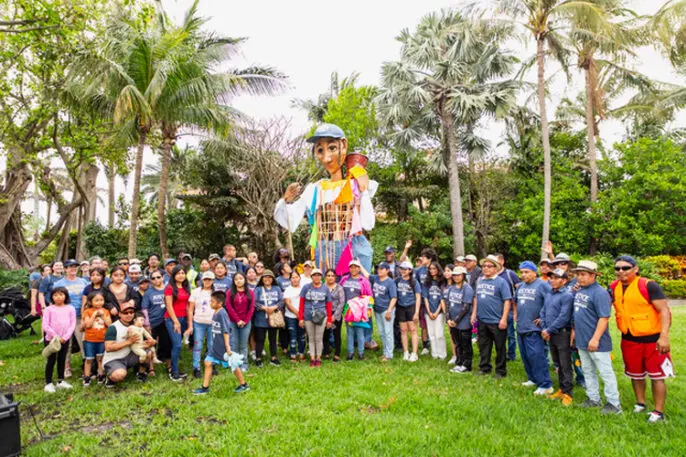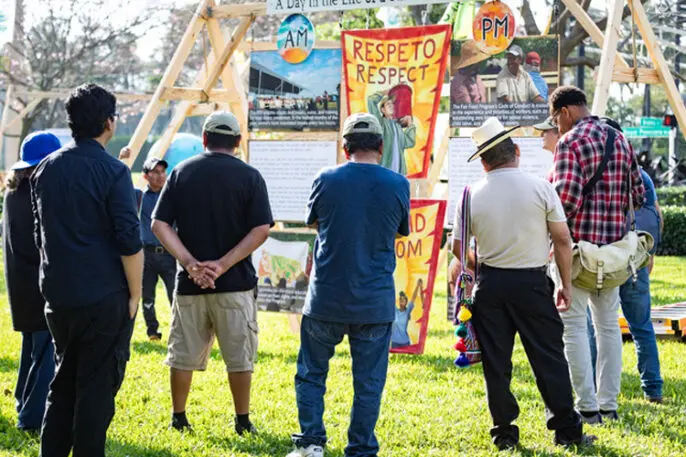In Palm Beach, farmworkers are ramping up pressure on Wendy’s to ensure worker protections
March 14, 2024
In Palm Beach, farmworkers are ramping up pressure on Wendy’s to ensure worker protections
During the Farmworker Freedom Festival last weekend, workers celebrated their hard-won protections—while also calling on Wendy’s to join their cause.
This past weekend, hundreds of farmworkers took to the streets of Palm Beach, Florida—an enclave for billionaires like Nelson Peltz, the chairman of Wendy’s and its largest shareholder. By their side was a 15-foot puppet in the form of an imagined farmworker named Esperanza, who led the way as workers embarked on a pilgrimage to the neighborhood of Peltz’s sprawling beachfront estate.
The puppet served as a physical embodiment of the sentiment that farmworkers like Nely Rodriguez wanted to capture through the Farmworker Freedom Festival, a three-day event put on by the Coalition of Immokalee Workers (CIW), an organization that advocates for the rights of farmworkers. “We wanted to make her larger than life,” Rodriguez says of the puppet, whose name means “hope” in Spanish. “That’s the size of the hope that we have.”
The farmworkers were in Palm Beach to celebrate more than a decade of winning workplace protections through the Fair Food Program—an initiative started by the CIW to improve working conditions on farms—and to send a message to Wendy’s, which is one of just a handful of major produce buyers who have refused to participate in the program. “The invitation that we’re trying to make to Nelson Peltz is that it’s important for him to reflect on the great power that he has, and the opportunity that he has to prevent the kinds of injustice and abuses that occur with agriculture workers,” Rodriguez says.
On Sunday, when workers brought Esperanza to Peltz’s doorstep, they took bandanas inscribed with their messages of hope and tied them together, creating a chain that they draped over the puppet. The bandanas symbolized the face covers that farmworkers often wear on the job to help shield them against the harsh sun and dust they endure in the fields.

“This was a really inspiring moment for me,” Rodriguez says. “It was an emotional thing to see and to participate in, as each worker put their bandana on this offering.” For Rodriguez and other female farmworkers, those bandanas don’t just protect against the elements. “We’ve seen and experienced the tremendous fear that women in the fields [face],” she says, “worrying that they’re going to lose their jobs and crying into those bandanas out of frustration and wishing that things were different.”
Beyond making a plea to Peltz and Wendy’s, the CIW also used the Farmworker Freedom Festival as an opportunity to highlight the working conditions that many farmworkers continue to face; an exhibit called the Modern-Day Slavery Museum documented the history of forced labor in Florida and how the practice continues to this day. Farmworkers have long faced some of the worst abuses on the job, from wage theft and sexual misconduct to instances of forced labor. (They were also some of the most vulnerable people during the pandemic, as frontline workers who often lived in close quarters.)
When Rodriguez first came to the U.S. and started working on farms, she knew very little about her rights as a worker, or what kind of recourse she had if a boss physically hurt her or behaved inappropriately. “It was well known that when a new woman would come and work on the crew, [bosses] would just pick them out as their own,” she recalls. “Sometimes they wouldn’t let the men working on the crew talk to women, because the idea was the women on the crew were the property of the crew leader.”

The Fair Food Program has changed these dynamics on many farms, according to Rodriguez and other workers. The origin of the program dates back to the late 1990s and grew out of the farmworkers’ protests and appeals to farm owners. (Farmworkers are excluded from the National Labor Relations Act, which protects the right to organize without fear of retaliation.)
After years of resistance, the coalition members turned their attention to corporations instead; if they could convince buyers to join their movement, it would put pressure on farms to come to the table. The Fair Food Program was formally launched in 2011, after the coalition managed to come to an agreement with tomato growers in Florida. Companies that agree to join the program must commit to paying a small premium—which is passed on to farmworkers through their paychecks—and to stop buying from farms that are found to be in violation of the program’s code of conduct (which was created by workers). In turn, participating farms get preferential treatment from those buyers.
Since the program’s inception, buyers have made more than $45 million in premium payments; the result is that workers receive an average weekly bonus of $24 in their paychecks (though the bonuses can be as high as $50 to $80).
It’s this market-based approach that the CIW believes has been key to enforcing the workplace protections secured by the program. But giving workers agency is an important component as well: Not only has the Fair Food Program educated workers on their rights but it also has empowered them to raise concerns about workplace safety without risking their livelihood.
Workers have access to a 24/7 complaint line to report any problems. The Fair Food Program has received and addressed more than 4,000 complaints to date, with fewer than 10 farms suspended over the life of the program. (Only the most serious violations lead to an immediate suspension.) The program also allows for much more oversight than what a government regulator like the Occupational Safety and Health Administration has the bandwidth to provide. Annual audits are conducted at each farm that participates in the program, which involves interviews with more than half of the workers.
“The Fair Food Program is not like a magic wand,” says Gerardo Reyes Chavez, a farmworker and CIW organizer who helped build the program. “The purpose is to be able to identify problems, investigate, and solve them. But it has gotten to the point of preventing the worst abuses that existed for generations in the agricultural industry.”
As a worker-led initiative, the Fair Food Program has been wildly successful, extracting legally binding agreements from the likes of Taco Bell, Walmart, McDonald’s, and Whole Foods (along with 10 other major buyers), and reaching 20,000 farmworkers across 10 states. It is now poised to expand significantly: Last fall, the Department of Agriculture conferred platinum status on worker-driven social responsibility programs like this one, incentivizing other farm owners to join through a new pilot program that offers up to $2 million in subsidies. The CIW has since received applications from more than 30 farms across 15 new states. (The Fair Food Program has also inspired other worker-led initiatives across the U.S.—and abroad.)
Over the past few years, the Fair Food Program has shored up additional workplace protections for farmworkers, including some of the most robust heat-safety rules in the country. Among those rules are required trainings for both workers and supervisors to help them identify heat stress, as well as mandatory rest breaks and electrolyte supplements. Perhaps the most surprising element is that workers and farm owners worked together to come up with these rules—a sign that even growers see value in the Fair Food Program’s protections.
“The remarkable thing here is that these protocols were born out of collaboration,” says Laura Safer Espinoza, the former director of the Fair Food Standards Council, which implements and monitors the program. “After almost a decade in the Fair Food Program [the growers] have definitely embraced the risk-prevention model.”
Despite all of this progress, a select group of major buyers has refused to budge and join their peers in the program. The CIW has been ramping up pressure on Wendy’s for eight years, starting with a boycott in 2016 and staging recurring actions since then. (Kroger and Publix are the other holdouts among major buyers; last year, the Department of Labor discovered forced labor in Kroger’s supply chain.)
After the Fair Food Program was established in Florida, Wendy’s reportedly stopped buying winter tomatoes from growers in the state and took its business to Mexico. (Wendy’s has previously denied this was related to the Fair Food Program.) In a statement, a company spokesperson said, “Wendy’s does not participate in the Fair Food Program because we do not purchase field grown tomatoes and there is no nexus between the program and our supply chain. Since 2019, we have sourced our North American tomato supply exclusively from indoor, hydroponic greenhouse farms, while the Fair Food Program predominantly operates in outdoor, conventional tomato growing environments.” As Espinoza points out, however, the greenhouses in the company’s supply chain could be brought into the program if Wendy’s opted in.
Wendy’s also told Fast Company that its “significant suppliers” must abide by a code of conduct and that “suppliers of certain hand-harvested, whole, fresh produce” are subject to third-party audits of their labor practices. (The efficacy of third-party reviews, which are now used by many companies in the food industry, has been called into question, as auditors have missed issues like child labor.)
Still, the ongoing pushback from companies like Wendy’s doesn’t seem to have dimmed the optimism of the workers behind the Farmworker Freedom Festival. After all, they know what’s at stake: According to the Economic Policy Institute, there are about 2.4 million farmworkers across the U.S., and while the Fair Food Program has helped countless farmworkers to date, there are far more who don’t yet have the same protections.
“I’m hopeful that Mr. Peltz will be able to see the beauty of connecting his brand to something that actually guarantees dignity for thousands of workers down their supply chain,” Chavez says. “I’m hopeful that all the attention the Fair Food Program is gaining will move [his] heart in the right direction.”
(21)



